THE FUJIKAWA MARU, TRUK LAGOON - BY DAY AND BY NIGHT
© Ian Robertson, 2003
History
The Fujikawa Maru, one of the most popular wrecks at Truk, was built in 1938 by Mitsubishi Zosensho of Nagasaki as a passenger-cargo ship (133 m long) for trade between the Orient, New York and the South China Sea. She was requisitioned by the Japanese Navy in 1940 as an armed aircraft transport and was fitted with breech-loading 152 mm bow and stern guns and a stern depth-charge system. She was one of about ten merchant ships converted to this new role, prior to Japans war involvement, and was used largely to deliver aircraft, spares, personnel and equipment to small island bases. She operated in the Aleutians, Rabaul, Yokosuka and the Gilbert and Marshall Islands.
In 1943, she was torpedoed by the US submarine Permit but was repaired. Later she was bombed at Kwajalein in the Marshall Islands and towed about 1600 km west to Truk by the Kembu Maru, arriving about January 15th 1944 to anchor SE of the airbase at Eten Island. She was torpedoed by aircraft from the US aircraft carrier Bunker Hill on February 17th but was still afloat the next morning. She was then bombed by aircraft from the Essex and left severely damaged and sinking by the stern. The coup de grace for this valiant little ship came at 7:15 am. An attack by torpedo bombers from the Monterey resulted in a huge explosion. She now lies upright on the sandy lagoon bottom in 37 m.
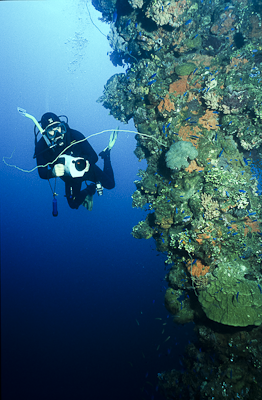
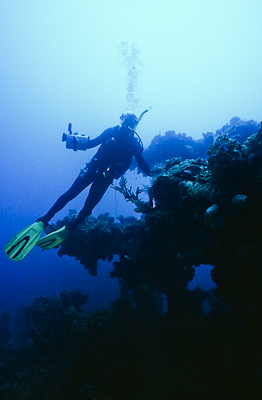
Mike Smith wields a video camera on the superstructure
that is encrusted with clams, sponges and hard and soft corals.
The Wreck and Holds
Mooring was off the bow, and the first sight is the high forecastle with its gun pointing over the starboard bow, its stark lines softened by a profusion of hard and soft corals in white, green and rusty brown. There is a bronze plaque on the gun breech, behind the splinter-shield, showing it was made in 1899 by the Elswick Ordnance Company of the UK, which supplied warships and armaments to the Imperial Japanese Navy. Nearby are boxes of ammunition.
The outside of the wreck is a spectacular garden of hard and soft corals, sponges, gorgonians, coral bushes, clams and white and black coral whips. There are also some magnificent carpet anemones with the obligatory pairs of fussy anemonefish. Although most of the aft mast is still standing, the foremast has now toppled backward at an angle on the starboard side. Heavy cargo booms extend forward over No 1 hold. On passing between the hatch beams, there are wedge-shaped aircraft fuel tanks, artillery shells and shell casings, loops of cable and the corroded remnants of a torpedo in the between-decks level. Passing between another set of hatch beams, the bottom of the hold contains two huge square steel containers. Around these is a clutter of aircraft parts and truck tyres, aircraft wheel rims, aero engines and their cowlings, propeller blades, shell casings, the corroded remnants of a machine gun, the skeletal remnants of aircraft control surfaces and fuel drums, all embedded in and dusted with a yellow, shell-rich silt.

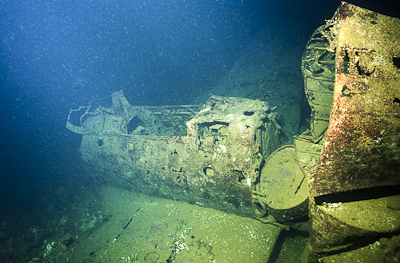
A jumble of fighter fuselages and wings in No 2 hold
illuminated by light from the open hatch.
among drums and wing parts.
In the bottom of No 2 hold, at 27 m, are some largely complete Zero A6M5 single seat fighter fuselages, one canted tail high, with a missing rudder and tailplane. There are also wings, one set attached to a fuselage. Most of the dural wing skins are in remarkably good condition, although the fabric cover of the control surfaces has rotted away, leaving a skeletal aluminium framework. In the cockpits, the seat backs and control columns are still there, but the instrument panels have been severely ‘ratted’ by souvenir hunters. All this lies amidst a jumble of large, pressure-crumpled fuel drums.
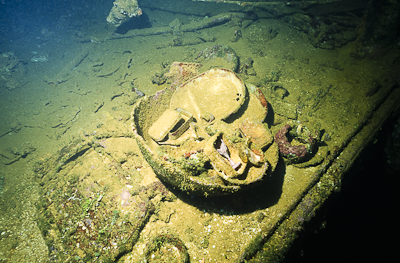
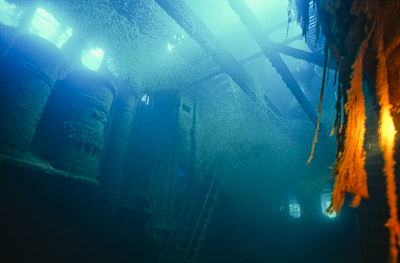
a stark reminder of the human occupants of the Fujikawa Maru
filtering from the skylights.
The upper-works in the bridge area are severely damaged, not just by fire but also by the ravages of corrosion over the last five decades. Some of the plating has corroded away and pieces litter the floor below, festooned with dangling wiring. Both rear holds had been largely unloaded prior to the air-strike and sinking, but the final torpedo strike left a huge hole blasted in the bottom of the ship and the metal plates are bent inwards like the petals of a flower.
The Engine Room and Workshop
The engine-room is special. Gliding in through the engine room skylight, I entered a vast cathedral-like space, bisected by a transverse catwalk, with railed, open stairways that provided crew access up and down but now readily accessible to divers, free of gravity. Huge, cylindrical tanks are clustered on one side and a gantry beam runs the length of the engine room. Soft blue light filters through numerous skylights above, partly obscured by clouds of small fish, giving a cloistered atmosphere. The lower part of the engine room is filled with astonishingly clear but slightly brown-tinged water, like extremely weak black tea. This is common in places surrounded by large amounts of rusting steel and where water circulation is limited. The water is probably anoxic, is devoid of fish but is the realm of bacteria. Six huge cylinders of the diesel engine lie in a line along the centre of the engine room floor. The cylinder heads, each secured with eighteen nuts, are served by an orderly array of pipes and manifolds. All is coated with a bubbly, bright yellow coat of rust. My light probed downwards into cramped passageways, lined with rusted pipes and dotted with hand valves in the lower-engine room spaces.
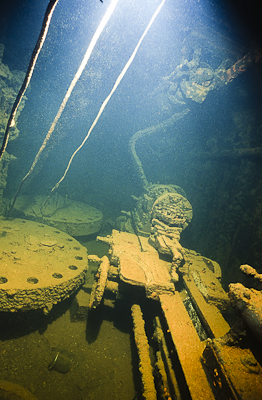
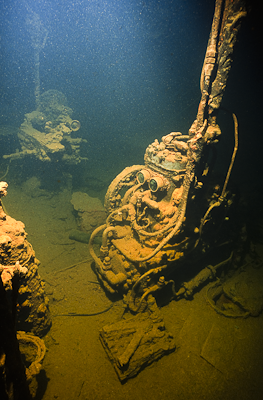
A metal lathe with belt and pulley drive above, the last repair job on
left and dangling electric cables in the engine-room workshop.
A corroded box of spanners lies nearby on the workshop floor.
There is a well-equipped workshop on the port side, and this I had to see, as an avid hobby machinist. It lies off the engine room, behind a grating, and is accessed up a small flight of steps and through several small entranceways. Moving very slowly, I eased my way inside, staying well above the floor, which is covered in thick silt, and shone my light around. Out of the blackness emerged two lathes, complete with chuck, saddle, tool-post, tailstock and what appeared to be two spare cylinder heads, probably part of the last repair job. Above were the remnants of the lathes' overhead pulley-and-belt drive. Nearby, were a drill press and a little air compressor with two dials, like eyes, staring across the workshop. A workbench, with two large vices and an open drawer, lay to one side. My strobe worked overtime.
By far the most photogenic was the air compressor. Rather than take the hackneyed frontal picture, that most people seem to take, I felt the charm was in the setting. I positioned myself to one side and held the strobe high, directing the light downwards, to dramatise the features of the compressor, highlighting a lathe in the background and a box of spanners on the floor nearby. The box had long since rotted away and the spanners had corroded and fused into a solid lump. Easing carefully out of the confined space, I returned to the deck level, noting the locations of profuse soft corals on the toppled mast, upperworks and cargo booms, to which I could return for the night dive.
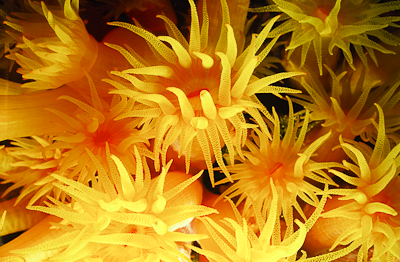
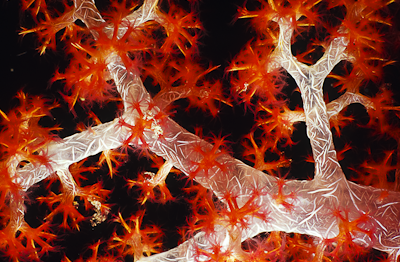
A Night Dive
Just before dinner we returned for a shallow macro-photo night dive. Ross Ezekiel brought my big dive light so I could concentrate on my old Nikonos (I) and rebuilt flash. The crew had clearly marked Odyssey’s bow and stern with underwater strobes. Their pulsing white light formed a halo above us, as we worked our way down the mooring line towards the Fujikawa. Here, we were met by a blaze of colour, fine delicate texture and activity, not seen during the day. No sooner had Ross spotted one photo subject, and I had settled down to capture it on film, than he was tugging my fin to direct me to the next. It was oh so easy to shoot through a film! Delicate feather stars (Mariametridae) in cream, red and brown paraded along the cargo booms where lemon yellow and white soft corals (Nephtheidae), tipped with pink, and red, branched invitingly. Some quite ordinary sea fans showed up in brilliant oranges and reds in artificial light. Minute shrimps foraged among them. Out of film, all I could do was look and wonder. We returned to Odyssey for the extended safety stop on the aluminium trapeze beneath the fan-tail and watched the antics of the fish that had been attracted to the blaze of light from the boat’s dive deck. The Fujikawa Maru is a magnificent wreck, both in the day and in the night but, for me, that engine-room and its workshop were truly magnificent.
Pictures taken with a Nikonos V on Kodak Ectachrome - Macro using a Nikonos I
Article previously published in Dive Log Australia March 2003, No 176 p 42.